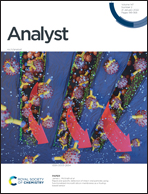Determination of dopamine based on a temperature-sensitive PMEO2MA and Au@rGO-MWCNT nanocomposite-modified electrode†
Abstract
First, the nanocomposite Au@rGO-MWCNT was synthesized by a hydrothermal method. Next, a temperature-controlled composite sensing film was prepared by composite modification of poly(2-(2-methoxyethoxy)ethyl methacrylate) (PMEO2MA) and Au@rGO-MWCNT on a glassy carbon electrode (GCE). This sensor was shown to exhibit good temperature sensitivity and reversibility to dopamine. When the testing temperature is lower than the lower critical solution temperature (LCST) of the polymer, the PMEO2MA chain is in a stretched state, which increases the distance between the Au@rGO layers and leads to the inability of MWCNTs in one layer to contact another Au@rGO layer and to low conductivity. Therefore, in this state, dopamine cannot detect an electrochemical signal, and it is termed an “off” state. When the temperature is higher than the LCST of the polymer, the PMEO2MA chain shrinks, allowing the MWCNTs to make contact with another layer of Au@rGO; the electron transfer rate of the modified film increases, and the electrochemical behavior of dopamine turns to an “on” state. Moreover, the sensor has a wide detection range (0.1 to 9.0 μM and 9.0 to 239.0 μM), and the limit of detection of dopamine is as low as 30 nM. This method has been successfully applied to the determination of dopamine in human serum samples. The on–off sensor provides a new avenue for the application of temperature-sensitive polymers.



 Please wait while we load your content...
Please wait while we load your content...